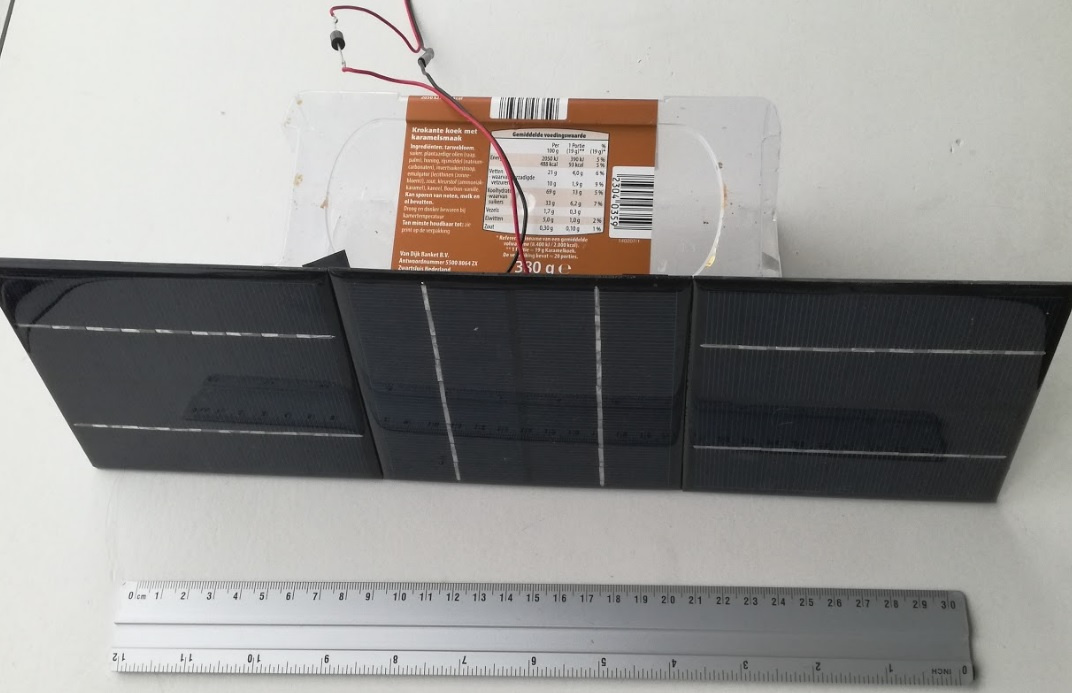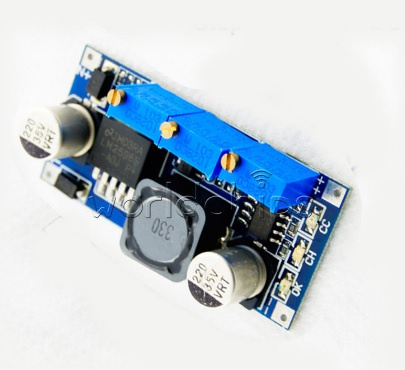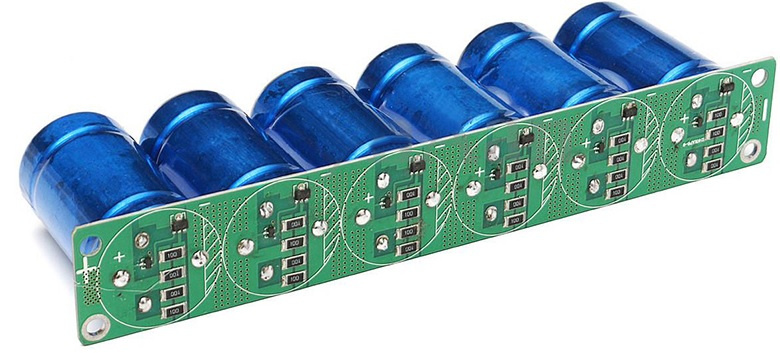Free energy or how to make a nightlight on ionistors and solar battery
Hello geektimes! In the previous part, we talked about testing the ionistor battery, finally it was time to use them somewhere. According to the results of the previous test, it turned out that the LED tape on the 6x500F battery at full brightness lasts for about 10 minutes. This, of course, is not enough, so it was decided to make a night light - at a low brightness of the light, it would be enough for a long time. What came out of it, the details under the cut.
For a start, under the spoiler, a small addition about the ionistor battery itself.
It was interesting for me to connect them to the solar battery, which resulted in the prototype night light described below. At night, the apartment is dark, and low background lighting will be just the way.
“Profi” from the below described are unlikely to learn something new, but for beginners it may be interesting.
For the charge, 3 Chinese solar panels bought with a capacity of 1.5W and 9V each were used (issue price $ 3.99 / piece). At idle, they really gave out about 10V, the short-circuit current when illuminated through window glass was about 100mA. In fact, 3 things turned out to be neither 30V for charging a 16-volt battery a lot, you must take either 2 or 4. The panels are connected to the ionistors in series through a powerful diode (needed so that the ionistors are not discharged through the panels at night). Of course, connecting through a diode is not the most efficient way to remove energy from batteries, it’s not MPPT and not even PWM, but cheap and reliable.
In the test version, the whole design of 3 batteries glued with tape to the cookie box and a diode looks like this:

As practice has shown, even on a sunny day, the diode does not heat up (a discharged ionistor battery is actually equivalent to a short circuit for solar panels). In clear weather, by the middle of the day, the ionistor battery is charged up to 15V, then this voltage lasts until evening. The windows face east and the sun shines only in the morning, so that in the afternoon, the panels are more likely to compensate for self-discharge.
The following components were used for the nightlight:
1) Three 1-watt LEDs of warm glow (issue price $ 1 for 10pcs)

2) LED driver with support for CC-CV (issue price $ 2)

Unlike conventional batteries, ionistors are discharged linearly, so that the voltage on them varies widely, so a led driver is needed. The driver must have an adjustable current, this is important, otherwise the LEDs will light only at full power, and you will get a flashlight and not a night light. In my case, by rotating the potentiometer, I set a comfortable level of brightness, which turned out to be about the same level as a regular candle.
On the table, it looks like this:

3) Finally, in order for “this” to become a nightlight, a photo relay was purchased, with a long name DC 5-18V Solar Light Control Switch Module Controller Night Work / Day Off (issue price $ 4.59).

There are 2 options for the relay, Night Work / day Off and vice versa, it is important not to confuse. In general, the whole structure, the photocell input is connected to the ionistors, the photocell output is connected to the LED driver. The light level for triggering the relay can be adjusted by the trimmer resistor inside.
The system turned out to be efficient and quite convenient. In the evening, at about 22 o'clock, the LEDs light up, the accumulated charge is enough for 4-6 hours per day, in the morning the charge starts again. It is important to remind that, unlike lithium or lead batteries, the number of ionistor cycles is ideally almost unlimited, so the number of cycles or the “memory effect” cannot be thought of (in practice, like an electrolytic capacitor, an ionistor can of course lose its capacity over the years ). In general, it turned out quite night-light for home use on free solar energy.
Of course, there is no talk about economic efficiency - at the moment ionistors are about 10 times more expensive than conventional batteries and have 10 times less energy density (W * h / kg). However, due to the possibility of returning large currents, the possibility of charge and discharge at low temperatures, and an almost unlimited number of cycles, they are very interesting and promising. Well, of course, it is always interesting to test something new.
In the future, it is planned to test the charge and discharge of ionistors at different loads. Stay tuned.
For a start, under the spoiler, a small addition about the ionistor battery itself.
Spoiler
In my case, a battery of 6 ionistors and a protection board was ordered on eBay and looked like this:

')
Alas, the seller did not take care of the good packaging of the parcel, 2 transistors on the board from the impact during the shipment burst at all, and of course the protection did not work. The voltage on the ionistor should not exceed 2.7V, in real life measurements showed a variation of values on a charged board from 0.8 to 3.5V, which of course is no good. I received a partial refund from the seller and ordered a new protection board separately, the board looks like this:

The new board turned out to be even more convenient to use, for example, there are LEDs on it, showing that a particular ionistor is already charged (in previous versions of the board, many doused them on their own).
Testing the ionistor battery with a charging current of only 2.5A showed 2 important points:
- The principle of operation of the protection board consists in “dropping” the excess voltage on the resistors when the ionistor voltage is above 2.7V. Surplus is obviously produced in heat. So, already at 2.5A, the resistors and transistors on the board were so hot that it was really hot to hold the finger.
- The resistors on the board do not have time to "reset" the voltage even with such a small current - the voltage on the charged ionistor reached 3.3V, and only after 1-2 minutes it began to decrease. Perhaps there is some hysteresis, it is difficult to say, but the fact is, the protection of this board is far from 100%.
An important conclusion follows from this: although the ionistors themselves can theoretically hold very large charging currents, this protection card (its full name is Super Capacitor Balance Protection Board) is, at best, designed for charging currents 1-2A. Therefore, the words in the description of the board “Maximum charge current (A): unrestricted” are most likely a “slight” Chinese exaggeration - if you apply for a fee, for example, 20A, then the balancing resistors on the board most likely just evaporate. However, when charging with small currents, there will most likely be no problems with balancing.

')
Alas, the seller did not take care of the good packaging of the parcel, 2 transistors on the board from the impact during the shipment burst at all, and of course the protection did not work. The voltage on the ionistor should not exceed 2.7V, in real life measurements showed a variation of values on a charged board from 0.8 to 3.5V, which of course is no good. I received a partial refund from the seller and ordered a new protection board separately, the board looks like this:

The new board turned out to be even more convenient to use, for example, there are LEDs on it, showing that a particular ionistor is already charged (in previous versions of the board, many doused them on their own).
Testing the ionistor battery with a charging current of only 2.5A showed 2 important points:
- The principle of operation of the protection board consists in “dropping” the excess voltage on the resistors when the ionistor voltage is above 2.7V. Surplus is obviously produced in heat. So, already at 2.5A, the resistors and transistors on the board were so hot that it was really hot to hold the finger.
- The resistors on the board do not have time to "reset" the voltage even with such a small current - the voltage on the charged ionistor reached 3.3V, and only after 1-2 minutes it began to decrease. Perhaps there is some hysteresis, it is difficult to say, but the fact is, the protection of this board is far from 100%.
An important conclusion follows from this: although the ionistors themselves can theoretically hold very large charging currents, this protection card (its full name is Super Capacitor Balance Protection Board) is, at best, designed for charging currents 1-2A. Therefore, the words in the description of the board “Maximum charge current (A): unrestricted” are most likely a “slight” Chinese exaggeration - if you apply for a fee, for example, 20A, then the balancing resistors on the board most likely just evaporate. However, when charging with small currents, there will most likely be no problems with balancing.
It was interesting for me to connect them to the solar battery, which resulted in the prototype night light described below. At night, the apartment is dark, and low background lighting will be just the way.
“Profi” from the below described are unlikely to learn something new, but for beginners it may be interesting.
Charge
For the charge, 3 Chinese solar panels bought with a capacity of 1.5W and 9V each were used (issue price $ 3.99 / piece). At idle, they really gave out about 10V, the short-circuit current when illuminated through window glass was about 100mA. In fact, 3 things turned out to be neither 30V for charging a 16-volt battery a lot, you must take either 2 or 4. The panels are connected to the ionistors in series through a powerful diode (needed so that the ionistors are not discharged through the panels at night). Of course, connecting through a diode is not the most efficient way to remove energy from batteries, it’s not MPPT and not even PWM, but cheap and reliable.
In the test version, the whole design of 3 batteries glued with tape to the cookie box and a diode looks like this:

As practice has shown, even on a sunny day, the diode does not heat up (a discharged ionistor battery is actually equivalent to a short circuit for solar panels). In clear weather, by the middle of the day, the ionistor battery is charged up to 15V, then this voltage lasts until evening. The windows face east and the sun shines only in the morning, so that in the afternoon, the panels are more likely to compensate for self-discharge.
Discharge
The following components were used for the nightlight:
1) Three 1-watt LEDs of warm glow (issue price $ 1 for 10pcs)

2) LED driver with support for CC-CV (issue price $ 2)

Unlike conventional batteries, ionistors are discharged linearly, so that the voltage on them varies widely, so a led driver is needed. The driver must have an adjustable current, this is important, otherwise the LEDs will light only at full power, and you will get a flashlight and not a night light. In my case, by rotating the potentiometer, I set a comfortable level of brightness, which turned out to be about the same level as a regular candle.
On the table, it looks like this:

3) Finally, in order for “this” to become a nightlight, a photo relay was purchased, with a long name DC 5-18V Solar Light Control Switch Module Controller Night Work / Day Off (issue price $ 4.59).

There are 2 options for the relay, Night Work / day Off and vice versa, it is important not to confuse. In general, the whole structure, the photocell input is connected to the ionistors, the photocell output is connected to the LED driver. The light level for triggering the relay can be adjusted by the trimmer resistor inside.
results
The system turned out to be efficient and quite convenient. In the evening, at about 22 o'clock, the LEDs light up, the accumulated charge is enough for 4-6 hours per day, in the morning the charge starts again. It is important to remind that, unlike lithium or lead batteries, the number of ionistor cycles is ideally almost unlimited, so the number of cycles or the “memory effect” cannot be thought of (in practice, like an electrolytic capacitor, an ionistor can of course lose its capacity over the years ). In general, it turned out quite night-light for home use on free solar energy.
Of course, there is no talk about economic efficiency - at the moment ionistors are about 10 times more expensive than conventional batteries and have 10 times less energy density (W * h / kg). However, due to the possibility of returning large currents, the possibility of charge and discharge at low temperatures, and an almost unlimited number of cycles, they are very interesting and promising. Well, of course, it is always interesting to test something new.
In the future, it is planned to test the charge and discharge of ionistors at different loads. Stay tuned.
Source: https://habr.com/ru/post/370643/
All Articles